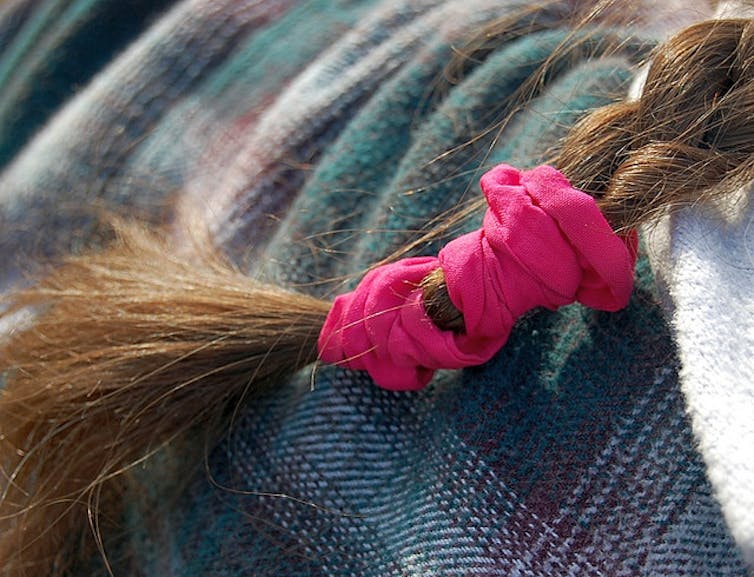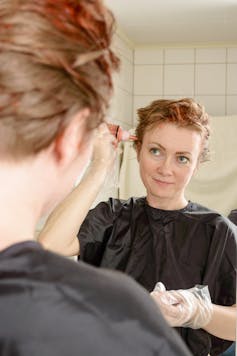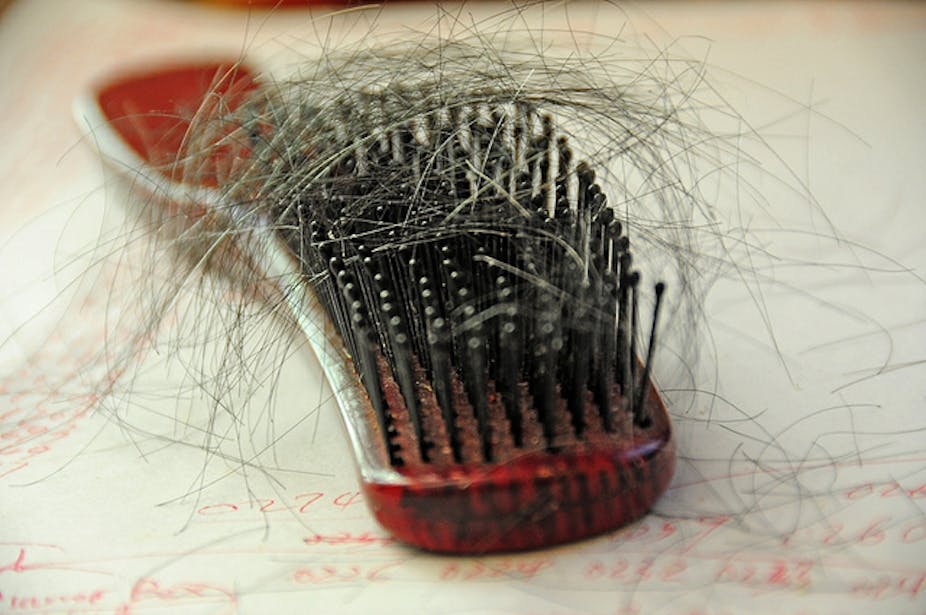Balding in men is so common it doesn’t raise an eyebrow. But when a woman starts to lose hair, it can be extremely distressing. Will she end up bald, too?
Help, I’ve got alopecia!
The term alopecia means hair loss. It doesn’t describe the type or the cause of a particular sort of hair loss; women can lose significant amounts of hair for a number of very different reasons.
Everyone knows chemotherapy can make hair fall out. But after the medical treatment hair will grow again.
Similarly, hair over the entire scalp can be shed because of other medications, pregnancy, thyroid disorders, major surgery, fever, blood loss, iron deficiency, starvation and crash dieting. The shedding, called telogen effluvium, can last two or three months before the woman recovers completely, although occasionally it can become chronic.
Then there’s alopecia areata, an autoimmune condition said to have affected Marie Antoinette, where clumps of hair fall out and leave bald patches.
Female pattern hair loss (FPHL) is quite distinct from all these types of hair loss. It is a genetic condition and almost 60% of Australian women are predisposed to it.
The course of FPHL differs from woman to women: some will be affected almost as soon as they reach puberty; others may remain unaffected until after menopause. But once it starts, an additional 5-10% of hair will be lost each year, mostly from the crown.
An additional problem for many women is how little hair and health professionals know about the condition. Initial visits may result in comments such as, “It’s just stress/pregnancy/the weather — it’ll grow back.” Or, “You’re imagining things! You have plenty of hair.”
Women don’t tend to overstate their hair loss as a rule. If anything, they perceive it as less severe than it really is. It can be crushing to have worked up the courage to seek help only to be told you are overreacting.
What’s the pattern?
Female pattern hair loss begins with diffuse thinning over the top and front parts of the scalp, most noticeably in the centre. While the hair loss is most pronounced on the crown, hair can also thin from ear to ear. The back of the head is least affected.
Most women affected by FPHL notice increased hair shedding before they become aware of a loss of hair volume over the crown. Others don’t notice their hair shedding, yet see their hair has reduced in volume or has less body. Women who have long hair may notice their ponytail becoming thinner.

At first, the shedding or thinning occurs in fits and bursts. Episodes last anywhere between three and six months and may then abate for one to two years before recurring. Over time, the episodes occur progressively closer together, until some women find they are shedding all year round.
Even in advanced FPHL, the affected area does not become completely bald and the hairline is always retained.
The root of the problem
When a doctor diagnoses you with FPHL, rest assured nothing you’ve done to your hair or scalp has caused it. Colouring, perming, blow-drying, frequent hair washing (or no washing at all) are not the culprits. Nor are the environment, diet, emotional factors or stress.
While you’re concerned about the appearance of the hair you can see, it’s what you can’t see that’s governing your hair loss. Hair grows from hair follicles: minute, sock-like indentations in the skin. Everyone’s born with more than two million of them over their entire body, including around 100,000 on the scalp.
No new follicles develop after birth. In fact, we lose a small number each year as we age, but each one will produce a number of hairs during the course of our lives. These follicles are where all the action – or inaction – takes place. In fact, the lower part of a follicle is the only section where hair is alive.
In FPHL, the hair follicles don’t disappear. Instead, they undergo a process of miniaturisation and produce only short fine miniaturised hairs. Initially only some follicles are affected. Over time more and more follicles miniaturise.
Genes and hormones
The natural colour and curliness, or otherwise, of your hair is a genetic lottery. So too is the matter of whether or not you are going to keep producing the hair on your head by natural means. Yes, you can blame your parents for FPHL – even if neither they nor your siblings show any sign of hair thinning.
Rather than there being a single gene behind FPHL, scientists now believe that at least five genes are involved. How these genes combine determines whether you will develop FPHL, how fast the condition will progress and how much hair you will ultimately lose.

One thing we know for certain is that FPHL occurs when a woman with an inherited predisposition to the condition is exposed to androgens: hormones that, among other things, affect cells in the hair follicle at a critical stage of hair growth.
In women with a genetic predisposition to FPHL, androgens cause the miniaturisation of susceptible scalp hair follicles. The affected follicles become smaller and smaller until they are no longer able to support normal hair production.
Over time, this process results in affected scalp hairs becoming smaller, shorter and finer than the ones they are replacing. Hairs on the top of the head are more sensitive to androgens than those on the back of the head which, in part, explains the pattern of hair loss over the scalp.
Heading for treatment
Most people with dermatological problems such as psoriasis, eczema or acne don’t think twice about starting medical treatment promptly. Yet six months or even a year may pass before a woman seeks help for losing her hair. During that time she may have put the loss down to stress, hormonal changes, the weather or illness.
This first year is critical. The sooner appropriate treatment is started, the better the results in the long term.
The three principal aims are to: arrest further progression, stimulate hair regrowth and conceal the hair loss. Most treatments achieve only two out of three goals.
Minoxidil stimulates regrowth but may or may not arrest further progression, at least in the long term. Minoxidil comes both as a lotion, which is applied directly to the scalp, and a tablet.
The lotion is available over-the-counter in pharmacies, while the tablets require a prescription from your doctor. Care is required with the tablets to find the correct dose that grows hair where it is wanted on the scalp without growing unwanted hair elsewhere.
Medications that block the effect of androgen hormones, such as spironolactone and cyproterone acetate, can halt further progression and may stimulate regrowth in some women. They can be taken on their own or while minoxidil is being applied.
Research shows hair loss is halted in more than 90% of women who use oral anti-androgens, while about 30-40% experience some regrowth. But it’s important that women do not become pregnant while taking anti-androgen medication.
A number of new agents are in the pipeline. The discovery that certain eye drops used to treat glaucoma made the eyelashes grow longer and thicker has led to renewed interest in prostaglandin inhibitors to treat hair loss. A number of shampoos and conditioners on the market contain prostaglandin inhibitors and can reduce hair loss and promote regrowth.
If you are losing your hair, remember, the most important thing you can do is seek help early. It’s much easier to prevent hair loss than to try and regrow it once lost.

